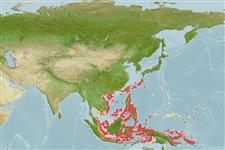>
Eupercaria/misc (Various families in series Eupercaria) >
Scaridae (Parrotfishes) > Scarinae
Etymology: Chlorurus: Greek, chloros = green + Greek oura = tail (Ref. 45335).
Eponymy: George Meade Bowers (1863–1925) was a Republican politician in the House of Representatives (1916–1923). He was the United States Commissioner of Fish and Fisheries (1898–1903) and Director of the US Bureau of Fisheries (1903–1913). (Ref. 128868), visit book page.
More on author: Snyder.
Environment: milieu / climate zone / depth range / distribution range
Ökologie
seewasser riff-verbunden; tiefenbereich 2 - 20 m (Ref. 90102). Tropical; 30°N - 9°S, 102°E - 163°E
Western Pacific: Philippines, Java (Indonesia), Ryukyu Islands, and Palau.
Size / Gewicht / Alter
Maturity: Lm ? range ? - ? cm
Max length : 40.0 cm TL Männchen/unbestimmt; (Ref. 48636)
Rückenflossenstacheln (insgesamt) : 9; Rückenflossenweichstrahlen (insgesamt) : 10; Afterflossenstacheln: 3; Afterflossenweichstrahlen: 9. Males are easily recognized by the bright orange patch. Females are similar to males but lack orange (Ref. 48636).
Inhabits channel and lagoon reef slopes, in coral-rich areas (Ref. 9710). Occurs singly (Ref. 9710).
Life cycle and mating behavior
Geschlechtsreife | Fortpflanzung | Ablaichen | Eier | Fecundity | Larven
Myers, R.F., 1991. Micronesian reef fishes. Second Ed. Coral Graphics, Barrigada, Guam. 298 p. (Ref. 1602)
IUCN Rote Liste Status (Ref. 130435: Version 2024-2)
Bedrohung für Menschen
Harmless
Nutzung durch Menschen
Tools
Zusatzinformationen
Download XML
Internet Quellen
Estimates based on models
Preferred temperature (Ref.
123201): 25.4 - 29.3, mean 28.8 °C (based on 1301 cells).
Phylogenetic diversity index (Ref.
82804): PD
50 = 0.5000 [Uniqueness, from 0.5 = low to 2.0 = high].
Bayesian length-weight: a=0.01514 (0.00834 - 0.02746), b=3.18 (3.01 - 3.35), in cm total length, based on LWR estimates for this species & (Sub)family-body (Ref.
93245).
Trophic level (Ref.
69278): 2.0 ±0.0 se; based on diet studies.
Widerstandsfähigkeit (Ref.
120179): mittel, Verdopplung der Population dauert 1,4 - 4,4 Jahre. (Preliminary K or Fecundity.).
Fishing Vulnerability (Ref.
59153): Low to moderate vulnerability (30 of 100).
Nutrients (Ref.
124155): Calcium = 41 [13, 126] mg/100g; Iron = 0.573 [0.218, 1.496] mg/100g; Protein = 18.1 [16.0, 20.0] %; Omega3 = 0.0559 [, ] g/100g; Selenium = 37 [11, 121] μg/100g; VitaminA = 47.9 [12.0, 185.2] μg/100g; Zinc = 2.25 [1.00, 4.17] mg/100g (wet weight);
